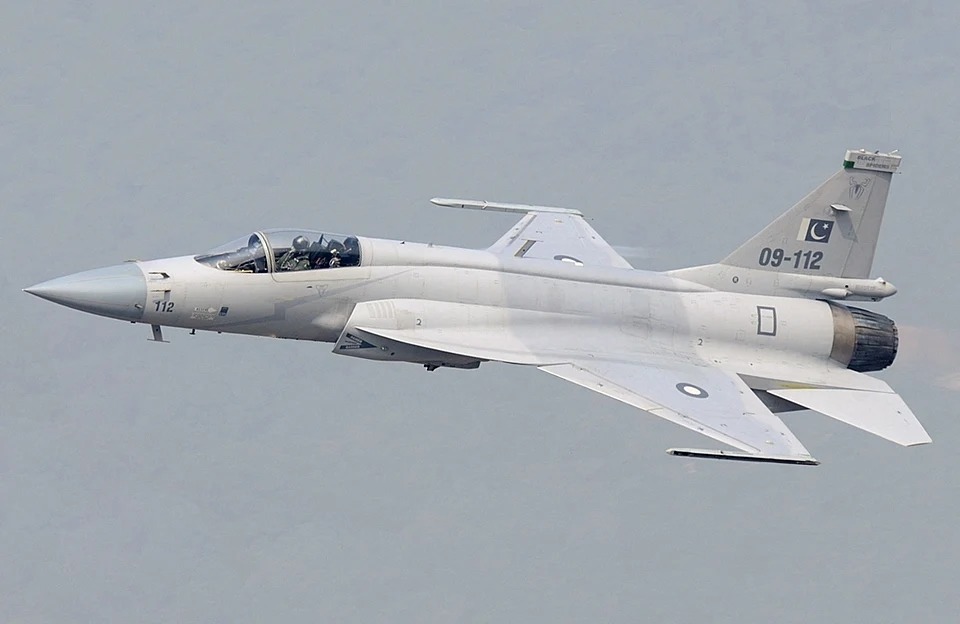Table of Contents
The JF-17 Fighter Jet, or Joint Fighter-17, is a multirole combat aircraft jointly built by China and Pakistan. It is the backbone of the Pakistan Air Force (PAF) and is frequently at the center of attention during military tensions, most recently during the India–Pakistan tensions in May 2025, when reports indicated that Indian air defenses downed two JF-17 aircraft during Pakistan’s retaliatory raids.
In this piece, we discuss the JF-17’s origins, technical details, variants, worldwide operators, and its place in contemporary air warfare.
JF-17 Thunder Overview
The JF-17 Thunder is a light, multi-role combat aircraft produced by Pakistan and China in collaboration to upgrade aging fleets and offer low-cost air combat capabilities. Since its induction into the Pakistan Air Force in 2007, it has been a symbol of local aviation development, providing a balanced combination of speed, maneuverability, and advanced warfare systems. Following is a summary of its main features:
| Feature | Details |
|---|---|
| Manufacturer | Pakistan Aeronautical Complex (PAC) & Chengdu Aircraft Corporation (CAC), China |
| Role | Multi-role combat aircraft |
| First Flight | August 25, 2003 |
| Introduced | March 2007 (in PAF service) |
| Unit Cost | Approx. $25–32 million (Block-wise) |
| Max Speed | Mach 1.6 (1,960 km/h) |
| Combat Radius | 1,352 km |
| Weapons Capacity | Over 3,600 kg (air-to-air, air-to-ground missiles, bombs) |
| Engine | Klimov RD-93 (Russian origin) |
Design and Features of the JF-17
The JF-17 Thunder is a light, single-engine, fourth-generation multirole fighter. It is made to be affordable, flexible, and able to use Chinese as well as Western weapons systems. Major design elements are:
-
Glass cockpit with digital avionics
-
Beyond-visual-range (BVR) combat capability
-
Fly-by-wire flight control
-
Night operation systems and air-to-air refueling
-
Low radar cross-section (for limited stealth)
It is capable of executing air superiority, precision strike, and reconnaissance missions.
JF-17 Variants Explained
| Variant | Key Features | Induction Period |
|---|---|---|
| JF-17 Block I | Initial production version with basic multi-role combat capabilities. | 2007–2013 |
| JF-17 Block II | Improved avionics, in-flight refueling, enhanced weapons integration; more than 50 aircraft produced. | 2013–2017 |
| JF-17 Block III | Latest and most advanced version with: – AESA Radar – Helmet-mounted display (HMD) – Infrared search and track (IRST) – Advanced EW suite – Enhanced BVR missile compatibility | 2019–Present (ongoing) |
| JF-17B | Twin-seat trainer and combat-capable variant used for advanced pilot training and light combat missions. | 2017–Present (in service) |
Countries Using the JF-17
Apart from Pakistan, several other countries have shown interest in or ordered the JF-17:
| Country | Status |
|---|---|
| Pakistan | Over 150 jets in service |
| Myanmar | First export customer (2018) |
| Nigeria | Received 3 jets (2021) |
| Azerbaijan, Iraq, Malaysia, Argentina | Expressed interest or signed MOUs |
JF-17 vs Indian Air Force Fighters
| Feature | JF-17 Block III | Tejas Mk1A / Mirage-2000 / Rafale |
|---|---|---|
| Engine | Russian RD-93 | GE F404/ Snecma M53 / M88-2 |
| Radar | KLJ-7A AESA (China) | Uttam AESA / RDY-2 / RBE2-AESA |
| Weapons | PL-15, SD-10 BVRs | Astra, MICA, Meteor, Hammer |
| Avionics | Modern (Chinese) | Indigenous + Western |
| Cost per unit | ~$30 million | $40–100 million (varies) |
Although the JF-17 Block III is upgraded with modern features, Indian jets such as the Rafale and Tejas Mk1A possess better radar, avionics, and missile capabilities. The Russian engine of the JF-17 is widely known to be a maintenance issue.
Role in May 2025 India-Pakistan Conflict
According to Indian defence sources, during Pakistan’s missile and drone assault on May 8, 2025, the Indian As per Indian defense sources, the Indian Air Force (IAF) had reacted to Pakistan’s missile and drone attack on May 8, 2025, by firing S-400 air defense systems and interceptors, which successfully destroyed several incoming targets. Indian reports said that:
-
Two JF-17s were downed near Punjab sector
-
One F-16 and a Saab 2000 AWACS were also shot down
These claims, though, are contested by Pakistan, and no independent visual proof has as yet authenticated the losses. Should it be true, this would be the first direct combat loss of JF-17s in a full-scale interstate exchange.
Criticism and Limitations
While praised for its affordability and modern capabilities, the JF-17 faces several issues:
-
Engine reliability (RD-93 heat management concerns)
-
Limited stealth or survivability vs advanced aircraft
-
High maintenance in tropical and dusty environments
-
Dependency on Chinese parts for upgrades and spares
Conclusion
The JF-17 Thunder has emerged as the icon of Pakistan’s indigenous military capability, providing a low-cost but capable fighter to developing air forces. The Block III has entered the 4.5-generation class with; however, its record in combat and survivability still stands under controversy.
With an increase in tension between India and Pakistan, performances of aircraft like the JF-17 Thunder will be viewed closely, not only for military action but also for stability in the region.


 Daily Quiz 01 July 2025
Daily Quiz 01 July 2025
 Special Intensive Revision (SIR) of Elec...
Special Intensive Revision (SIR) of Elec...
 National Doctor’s Day 2025: History, T...
National Doctor’s Day 2025: History, T...





















